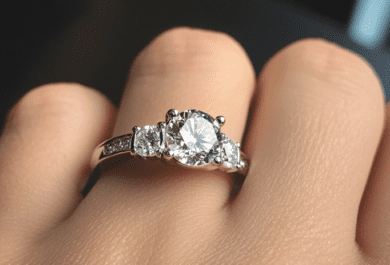Everyone knows diamonds. They are the lifeblood of our industry, but only a few know and really love colored gemstones. Be sure to find one of these people if you want the best value for your money
Now about color.
Again, quoting from the GIA workbook on Colored Gemstones:
“Color is an interplay between a light source, an object, and the human eye and brain. Most light sources emit light that is a combination (or blend) of various wavelengths of visible electromagnetic radiation. The object absorbs some wavelengths and transmits or reflects others to the eye. Receptors in the eye translate these wavelengths into an optical code which the optic nerve transmits to the brain, where they are interpreted as sensations of different colors.”
Translation. Light hits the object that we are looking at and is absorbed or reflected and we see it as different colors.
This is important!
Some stones will look completely different depending on whether they are seen in fluorescent light or incandescent light. ALWAYS look at a stone you are thinking of buying in several light situations. Get your jeweler to walk with you into a room with fluorescent lights, incandescent lights and if possible out of doors in shade and direct sun. Even consider the type of light where you will most be wearing the gem.
Back to “the book”.
“We describe color in terms of three dimensions – hue, tone, and saturation. These create a world of colors or color space. All colors perceived by the human eye can be placed within this world, and their position specified by their hue, tone, and saturation.
The color that is most prominent in a gemstone is called the dominant color. Other evident colors are called additional colors.”
I am going to paraphrase from here, in the
interest of not putting you all to sleep.
Hue is the basic impression of color that we notice immediately. Red, green, blue and the other rainbow colors are the basic hue names. Add in other descriptors and you get a better picture. For example, lets take the color wheel from the short journey between blue and green. Start with Blue, then shift slightly to very slightly greenish blue, and on around the wheel to greenish blue, very strongly greenish blue, green-blue or blue-green, very strongly bluish green, very slightly bluish green, and finally ending at green.
You can take a similar journey around the rainbow, joining the purple red up to the other violet end, which is why we call it a color wheel. The human eye can actually discern about 150 separate hues, but in gemology we use 31 on our hue chart.
Tone is the lightness or darkness of a color sensation, from colorless to black. Tone is divided into eleven steps from “0” being colorless or white through ever increasing shades of gray to “10” being black. In grading colored stones, we use seven of those steps, from “2 very light” through “8 very dark”. The terms describe the lightness or darkness of the color the eye perceives
“Saturation is the strength, purity, or intensity of the hue present in a color sensation.”
What we attempt to describe with saturation is how bright or how dull the color is. For example, with a blue stone here are terms we might use as we go up the scale from colorless to faint to strong, there are actually seven grades of saturation starting with Neutral, but for practical purposes we will use six modifiers for saturation.
Grayish blue, slightly grayish blue, very slightly grayish blue, moderately strong blue, strong blue, vivid blue.
Blue is considered a cool color and cool colors are typically modified in shades of gray. Warm colors such as orange will be typically modified in shades of brown.
When you put it all together, you might get a color description of a really beautiful sapphire such as this…
This sapphire has a medium dark, strong, violetish blue. Or if you are into scientific color notation, vB 6/5. (violetish blue, medium dark, strong)
Wowsers! That is more that I need to know about describing a stone.
Let me tell you why.
If you take the same courses that I have taken and practice for years and years, you and I will most of the time be at least in the same neighborhood when describing a stone to one another, provided we both have the same equipment to recreate the color descriptions that we are giving to one another. Hardly any of the wholesale dealers want buyers to be able to compare their prices.
But, you did not take the same course. And, you do not have the same equipment. And even if you did, my eyes are 55 years old. They don’t see the same as they did when they were 30. (Now there’s the shame, especially if you take your joy from looking at stones all day!)
My eyes will not see the same as yours. So after all that, if you like it buy it!
discuss











